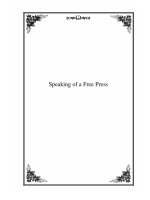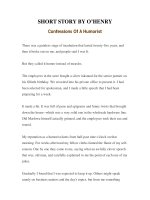birth of a nation art or propaganda
Bạn đang xem bản rút gọn của tài liệu. Xem và tải ngay bản đầy đủ của tài liệu tại đây (25.93 KB, 2 trang )
Mankind, engaging in war, driven by whatever instincts guide him,
seeks to keep the defeats and victories of battle in his memory and on his
conscience. To accomplish this men have used paint and canvas, ink
and paper, or instrument and song in their effort to communicate the
tragedy and glory of war. Never, before the career of D.W. Griffith had
anyone attempted to bring the subject to film. The result of his efforts,
weaknesses aside, mark a change in attitude towards film as a media.
Perhaps audiences previously going to a picture expected emotional
manipulation. After all, years before the film Birth of a nation, makers of
film employed techniques to evoke pathos from viewers; whether through
the use of a sobbing mother, a frightened child or what have you. In this
respect the film was not a ground-breaker; However, through its effective
use of devices such as symbolism, foreshadowing and allusions, as well
as building on and arguably perfecting film techniques such as continuity
editing, intercutting and close-ups, he transformed film from mere
entertainment to art and propaganda. To present and explore a theme,
symbolism is used everywhere in literature. Whether the image is subtle
or obvious it is regardless a sign of considerable calculation and effort. In
Birth of a nation Griffith places symbols everywhere, in doing this he
merges literary devices of written works with his own visual works. For
instance, the parched corn symbol in the scene where the southern army
is eating symbolizes their desperation in the face of defeat. This imagery
proves that Griffith wasn't just presenting actors and a plot, he intended to
dig far deeper than that, into the realm of a clever storyteller. Another
example of his unique style is the use of foreshadowing, another literary
device now commonly employed in film. The most prominent example of
this is the scene where two gentlemen are talking, and as the camera
pans down, we see a puppy struggling with a kitten. This is another
strong example of symbolism; however, even more importantly it
foreshadows the coming war. It is expertly placed to add to the building
tension between sides which the audience already knows results in
confrontation. Its placement reflects Griffiths desire to advance the
complexity and diversity of film beyond entertainment to higher levels in
society. To manipulate his audience's emotions, he first had to draw
them into the story and in turn into the stories underlying theme. He
accomplished this by using numerous virgin film tools, much as an artist
uses his own tools to create a believable painting. Among these tools he
uses panoramas to illustrate setting, to paint, if you will - a moving picture.
To show the swell of heated gunfire on a crowded battlefield i.e.the
scene of the battle of Petersburg, or to bring across image of the delicate
beauty of his native southern land to those who had never been there or
seen a picture of it. This was the substance that transformed film into a
genuine art form. Once he had the attention and anticipation of the
audience, as well as their almost guaranteed acceptance of his word, he
merely had to feed them a easily grasped, recognizable message to sway
their emotions his way. This method of classic propaganda was used to
fuel the audience's already considerable ill-founded hatred of blacks. It
comes in the form of a rebel black group who terrorizes the Cameron
family, the film's main characters. By placing blacks in this position it isn't
difficult to imagine the reaction of an average theatre goer. The film
spawned riots, fired up racism, built stronger the negative stereotypes of
blacks. It portrayed them as lazy, as illustrated in the black parliament,
where a man rests his bare feet on a desk, alluding to uselessness in the
employment environment. More horrifyingly than that it portrayed them
as ultimately evil with the seizing of the Cameron's home and the
attempted rape of one of their daughters. The obvious bias presented,
although appalling, demonstrates just how effective Griffith was at
utilizing film not with the intention to merely entertain, but to spread
propaganda and affect the perceptions of society itself. Griffith
exploited his audience, he turned them against minorities and
themselves. The film Birth of a nation exemplifies ignorance and hate at
its worst. Although it stands for something that today is looked on as
morally wrong, it proves by this very reaction that the film is not just mere
entertainment, but something with a far more serious purpose. Since
Griffith was the first to accomplish something of this nature, Birth of a
nation therefore marks the transformation of film from pure entertainment
into art and propaganda.









